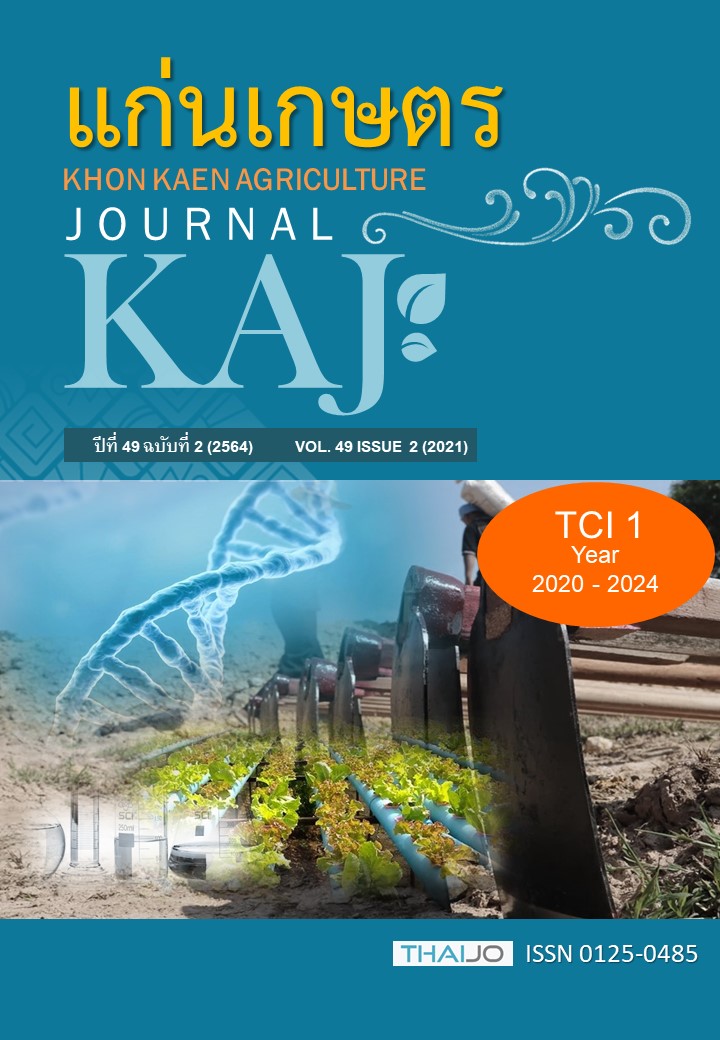การเปลี่ยนแปลงประชากรเพลี้ยไฟเมล่อน Thrips palmi Karny (Thysanoptera: Thripidae) และการเกิดโรคไวรัสในเมล่อน 2 สายพันธุ์ที่ปลูกภายใต้สภาพโรงเรือน
Main Article Content
บทคัดย่อ
เพลี้ยไฟเป็นแมลงศัตรูสำคัญต่อการปลูกเมล่อนในสภาพโรงเรือนที่สร้างความเสียหายต่อผลผลิตเมล่อนอย่างมาก วัตถุประสงค์การวิจัยครั้งนี้เพื่อประเมินชนิดและความหนาแน่นของประชากรเพลี้ยไฟตัวเต็มวัยในโรงเรือน โดยการใช้กับดักกาวเหนียวสีเหลืองติดตั้งภายในโรงเรือน และประเมินความเสียหายของผลผลิตในเมล่อนต่างสายพันธุ์ ในช่วงเดือนมีนาคม 2562 - กุมภาพันธ์ 2563 ผลการทดลองพบการเข้าทำลายของประชากรเพลี้ยไฟเมล่อน Thrips palmi Karny มากที่สุด ในระยะเจริญเติบโตทางลำต้นและระยะก่อนเก็บเกี่ยว ช่วงเดือนมีนาคม โดยมีความแตกต่างอย่างมีนัยสำคัญยิ่งทางสถิติต่อระยะอื่นๆและเดือนอื่นๆ (P<0.01) ไม่พบความสัมพันธ์ระหว่างจำนวนประชากรเพลี้ยไฟในโรงเรือน อุณหภูมิ และความชื้นสัมพัทธ์ที่เปลี่ยนแปลงไป (P>0.05) โดยความเสียหายของผลผลิตที่เกิดจากเชื้อไวรัส พบว่าสายพันธุ์เมล่อนทั้ง 2 สายพันธุ์พบความเสียหายจากเพลี้ยไฟที่แตกต่างกันอย่างมีนัยสำคัญยิ่งทางสถิติ (P<0.01) ข้อมูลที่ได้รับสามารถนำไปปรับใช้ต่อการจัดการเพลี้ยไฟศัตรูเมล่อนในระบบฟาร์มต่อไป
Article Details

อนุญาตภายใต้เงื่อนไข Creative Commons Attribution-NonCommercial-NoDerivatives 4.0 International License.
เอกสารอ้างอิง
นุชจิรา ไชยวัน รุจ มรกต และ จริยา รอดดี. 2562. การเปลี่ยนแปลงประชากรตามฤดู กาลของแมลงศัตรูเมล่อน. แก่นเกษตร. 47(ฉบับพิเศษ 1): 932-946.
สมฤดี สีหาเวช และ อุบล ตังควานิช. 2560. การศึกษาแมลงศัตรูเมล่อนในพื้นที่ควบคุม. แก่นเกษตร. 45 (ฉบับพิเศษ 1): 1372-1377.
สำนักงานเกษตร และสหกรณ์. 2560. ข้อมูลเพื่อการวางแผนพัฒนาการเกษตรและสหกรณ์ รายสินค้าของจังหวัดสุพรรณบุรี เมล่อน. กระทรวงเกษตรและสหกรณ์, สุพรรณบุรี.
ศิริณี พูนไชยศรี. 2544. เพลี้ยไฟ. พิมพ์ครั้งที่ 1. โรงพิมพ์คุรุสภาลาดพร้าว กองกีฏและสัตววิทยา กรมวิชาการเกษตร, กรุงเทพฯ.
อรัญ งามผ่องใส. 2549. การระบาดและความเสียหายของมังคุดที่เกิดจากเพลี้ยไฟในภาคใต้ของประเทศไทยและแนวทางการควบคุม. รายงานวิจัยฉบับสมบูรณ์. คณะทรัพยากรธรรมชาติ มหาวิทยาลัยสงขลานครินทร์, สงขลา.
Atakan, E. and R. Canhilal. 2004. Evaluation of yellow sticky traps at various heights for monitoring cotton insect pests. Journal of Agricultural & Urban Entomology. 21: 15-24.
Bacci, L., M.C. Picanco, M.F. Moura, A.A. Semeao, F.L. Fernandes, and E.G. Morais. 2008. Sampling plan for thrips (Thysanoptera: Thripidae) on cucumber. Neotropical Entomology. 37: 582-590.
Chakraborty, R., K. Tyagi, S. Kundu, I. Rahaman, D. Singha, K. Chandra, S. Patnaik, and V. Kumar. 2018. The complete mitochondrial genome of Melon thrips, Thrips palmi (Thripinae): Comparative analysis. PLoS One. 13: e0199404.
Chiemsombat, P., O. Gajanandana, N. Warin, R. Hongprayoon, A. Bhunchoth, and P. Pongsapich. 2008. Biological and molecular characterization of tospoviruses in Thailand. Archives of Virology. 153: 571–577.
David, A. 2015. Varieties of of Melons. Available: https://goo.gl/n9w5ot. Accessed Jan. 10, 2019.
Gharekhani, G.H., S. Ghorbansyahi, M. Saber, and M. Bagheri. 2014. Influence of the colour and height of sticky traps in attraction of Thrips tabaci (Lindeman) (Thysanoptera: Thripidae) and predatory thrips of family Aeolothripidae on garlic, onion and tomato crops. Arch Phytopathology Plant Protection Science. 47: 2270-2275.
Hassan, A.A., and A. D. Mohammed. 2004. Trapping efficiency of various colored traps for insects in cucumber crop under greenhouse conditions in Riyadh, Saudi Arabia. Pakistan Journal of Biological Sciences. 7: 1213-1216.
Kato, K., K. Hanada, and M. Kameya-Iwaki. 1999. Transmissions mode, host range and electron microscopy of a pathogen causing a new disease of melon (Cucumis melo) in Japan. Annals of the Phytopathological Society of Japan. 65: 624–627.
Kirk, W. D. J. 1997. Thrips as Crop Pests. CAB International, Wallingford.
Hoddle, M.S, L. Robinson, and D. Morgan. 2002. Attraction of thrips (Thysanoptera: Thripidae and Aeolothripidae) to colored sticky cards in a California avocado orchard. Crop Protection (Guildford, Surrey). 21: 383–388.
Napier, T. 2009. Insect pests of cucurbit vegetables prime facts. Available: https://goo.gl/AB1Yn5. Accessed Jan. 10, 2019.
Palumbo, J. C., D.L. Kerns, and K. Umeda. 2000. Whitefly management on desert melons. Available: https://goo.gl/Ky8kPQ. Accessed Jan. 04, 2019.
Peng, J–C., S–D. Yeh, L–H. Huang, J–T. Li, Y–F. Cheng, and T–C. Cheng. 2011. Emerging threat of thrips-borne Melon yellow spot virus on melon and watermelon in Taiwan. European Journal of Plant Pathology. 130: 205–214.
Seal, D. R., and R. M. Baranowski. 1992. Effectiveness of different insecticides for the control of Thrips palmi Karny (Thysanoptera: Thripidae) affecting vegetables in south Florida. Florida State Horticultural Society. 105: 315-319.
Seal, D. R., and C. M. Sabines. 2012. Combating melon thrips, Thrips palmi Karny (Thysanoptera: Thripidae) in South Florida. Florida State Horticultural Society. 125: 196-200.
Supakitthanakorn, S., A. Akarapisan, and O. Ruangwong. 2018. First record of melon yellow spot virus in pumpkin and its occurrence in cucurbitaceous crops in Thailand. Australasian Plant Disease Notes. 13: 32.
Thongjua, T., J Thongjua, J. Sriwareen, and J. Khumpairun. 2015. Attraction effect of Thrips (Thysanoptera: Thripidae) to sticky trap color on orchid greenhouse condition. International Journal of Agricultural Technology. 11: 2451-2455.
Wang, C. L., and Y. I. Chu. 1986. Rearing method of southern yellow thrips, Thrips palmi Karny, in the laboratory. Plant Protection Bulletin. 28: 407-411.
Widana Gamage, S. M. K., D. Rotenberg, D. J. Schneweis, C. W. Tsai, and R. G. Dietzgen. 2018. Transcriptome-wide responses of adult melon thrips (Thrips palmi) associated with capsicum chlorosis virus infection. PLoS One. 13: e0208538.
Yadav, R., and N. T. Chang. 2014. Effects of temperature on the development and population growth of the melon thrips, Thrips palmi, on eggplant (Solanum melongena). Journal of Insect Science. 14: 78.


